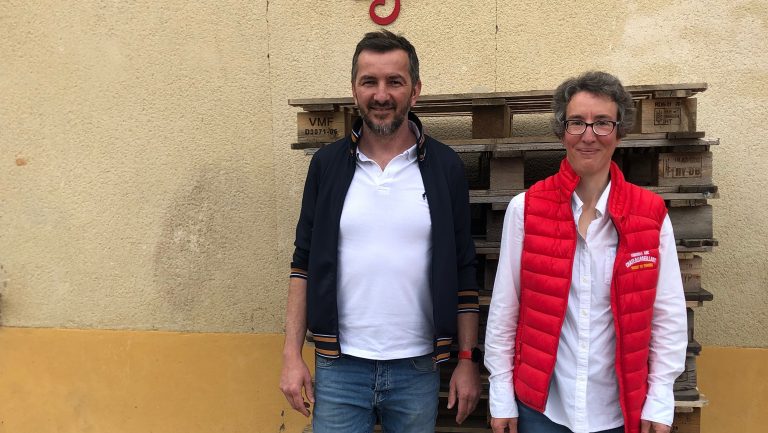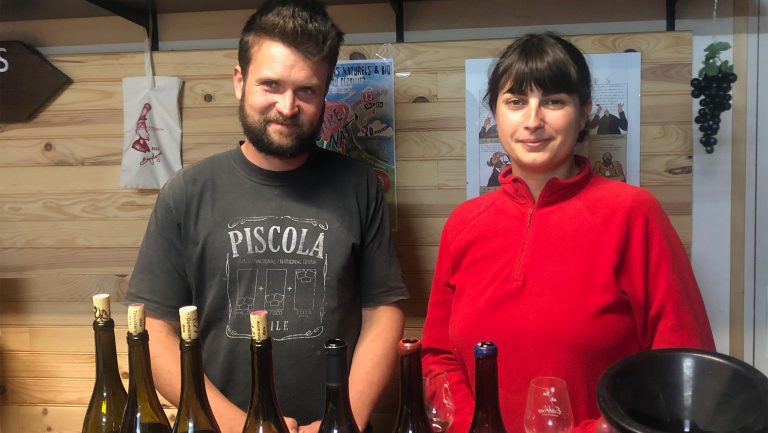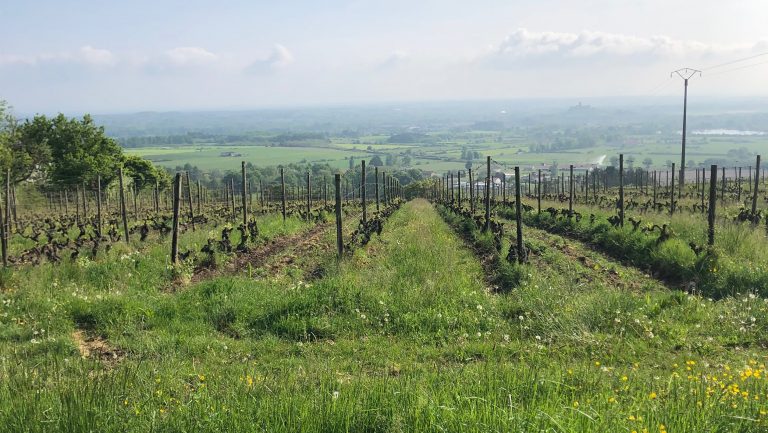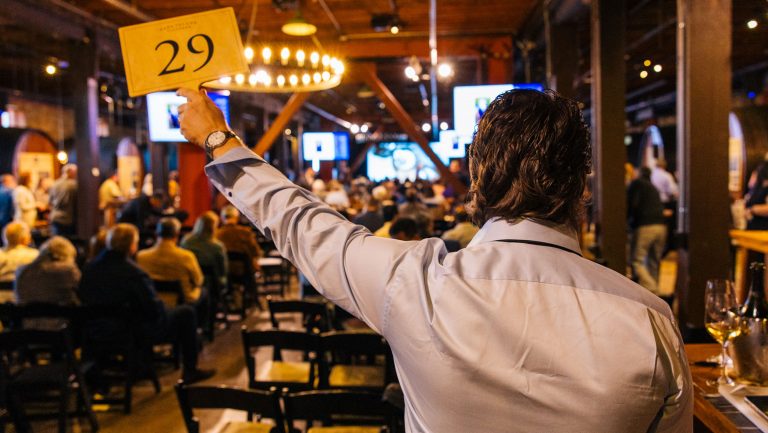These days, a whole bunch of producers are looking to extend the traditional map of the Loire Valley, which typically goes from Nantes, on the Atlantic coast, to the area around Sancerre and Pouilly-Fumé, in central France.
However, the source of the Loire River is somewhere southeast of this—between Clermont-Ferrand and Lyon, near Le Puy-en-Velay—and there are actually four wine appellations in this rather large stretch of land: Saint-Pourçain, Côtes d’Auvergne, Côtes du Forez, and Côte Roannaise. In 2019, feeling somewhat ignored by the rest of the Loire (and maybe the rest of the wine world), about 40 vignerons from these four appellations formed an association called Loire Volcanique, evoking the volcanoes that sculpted the region and a good portion of its soils.
Since its inception, the association has been working to bring attention to this group of appellations that are largely focused on Gamay—with a great range of expressions in a fairly diverse set of terroir conditions. Their group tastings have picked up steam as travel restrictions gradually loosened, and producers have been finding new buyers in France and abroad.

Don’t miss the latest drinks industry news and insights. Sign up for our award-winning newsletters and get insider intel, resources, and trends delivered to your inbox every week.
“Appellations lost in the middle of nowhere, and all these volcanoes around—there’s certainly a story to be told,” says Yvan Bernard of Les Chemins de l’Arkose, an organic estate in the Côtes d’Auvergne, which he founded about 20 years ago and now shares with fellow winemaker Audrey Baldassin. Although a good portion of the soils are more granite- or limestone-based, the term volcanic is tied to the region’s geology in the wider sense—and it also creates a catchy and attractive umbrella to distinguish the appellations from the ones downriver in Centre-Loire or the Val de Loire.
The emergence of the association is partly tied to an evolution in the kind of vignerons working in the area, explains Bernard. “When I started 20 years ago, we were the first generation who weren’t inheriting from vigneron parents, and who were coming in after studying viticulture and business,” he says. Today, the Loire Volcanique appellations get leadership from professionally trained vignerons, such as the internationally acclaimed Domaine Sérol in Côte Roannaise, where Stéphane and Carine Sérol make terroir-driven, age-worthy Gamays. Meanwhile, energy from a young generation is bringing new ideas and a strong desire to raise the bar and farm organically and sustainably.
The Road Less Traveled
Beyond a growing membership, the association certainly seems to appeal to a growing number of wine professionals and wine lovers interested in going off the beaten path. “These days, people are often looking for lesser-known appellations and grape varieties, so they can discover something new,” points out Sophie Roux, co-owner of her family’s estate, Domaine des Bérioles in Saint-Pourçain. This exceptional family estate makes some smashing wines from Gamay, Chardonnay, and Tressalier, a vivacious and complex white grape variety that was once the glory of the appellation, a few centuries ago.
Also known as Sacy in the northern reaches of Bourgogne, Tressalier has a bright acidity that shines through even in warmer vintages—something that could prove useful as hot summers become the norm, rather than the exception. It also provides something unique for the appellation to offer, and an opportunity to “bring the glory back to Saint-Pourçain,” as Ambroise Demonceaux, former Apple senior manager and co-founder of ambitious newcomer Clos de Breuilly, puts it. Breuilly, along with a few other estates like the excellent Domaine Grosbot-Barbara, are making refined cuvées with extended barrel-aging that could easily satisfy a lover of high-end white Bourgogne.

The smaller appellations of the Loire may also have an opportunity to diversify in a way that is less accessible to the larger ones. Sancerre is known for a very specific style of Sauvignon Blanc, and Chinon for more structured Cabernet Franc, for instance, and factors like market expectations and land costs make it more difficult to deviate from expected styles. Areas less bound to expectations, on the other hand, are freer to pursue different grapes and styles. Beyond their crunchy Gamays made in the Côtes du Forez or Côtes d’Auvergne appellations, vignerons from these volcanic regions also have the land and the leeway to make expressive whites from Pinot Gris, Viognier, or Gewürztraminer, bottled under the Pays d’Urfé IGP, as well as some reds from Pinot Noir or even Gamaret. The guiding principles for these plantings seem to be more about enjoyment, curiosity, and personal taste than market-driven necessity.
Those experiments go hand in hand with greater attention paid to specific terroirs. “Twenty years ago, we were just making Gamay,” says Jean-François Arnaud, the owner of Domaine du Poyet. Now, cuvées highlighting basalt or granite soils are most often made separately, showcasing different expressions of Gamay from a generally cooler area.
The differences are worth highlighting, in Forez and beyond. Volcanic Gamays tend to have more peppery notes, bright fruitiness, and grainier tannins. Those grown on granite, while a bit rounder and fruitier, still carry a spiciness that distinguishes them from their Beaujolais brethren. And in Côte Roannaise, producers proudly carry the torch of Gamay Saint-Romain, a type of Gamay that grows vertically and is more structured behind the usual bright red fruit.
The Value of Working Together
The renewed energy in smaller Loire appellations also comes from collective projects that compensate for the small size of the estates and appellations—and those aren’t limited to the Loire Volcanique. In Châteaumeillant, a tiny central Loire appellation that only covers 80 hectares of vines, 10 vignerons owning a total of 15 hectares have come together at the Cave de la Bidoire. In this alternative type of cooperative cellar, equipment is bought by the group and tasks are shared in both the cellar and the field. Each estate bottles its own wine, but they benefit from mutual support.
For a small producer like Domaine Goyer, who has two hectares under vine, along with cattle and grain production, the structure is what makes their wine production viable. “If we were on our own, we couldn’t afford the level of equipment that we have together at La Bidoire,” says owner Claire Goyer, who makes a bright rosé and some juicy reds from Gamay. Other producers based in nearby appellations, like Vincent Siret-Courtaud of the white-only appellation of Quincy, have been able to use La Bidoire to add reds and rosés to their range without having to create a new estate.

Mikaël and Camille Hyvert, the owners of Domaine des Trouillères in the Côtes d’Auvergne who are among the younger producers in the Loire Volcanique, point out that the association has also been building up mutual assistance. “There have been seminars on organics and biodynamics and there is an exchange of information that helps winegrowers grow and improve,” says Camille Hyvert. In smaller, more isolated areas of production and for smaller producers, this pooling of resources becomes all the more important.
This pooling also applies to working on various farm products, in addition to wine. “Polyculture remains quite frequent,” points out Julie Logel, co-manager of leading organic Côtes-du-Forez producer Verdier-Logel, where her father Jacky was one of the first to export internationally in the Volcanique appellations. Indeed, raising livestock or growing grain can be necessary to earn a proper living if wine production only takes place on a few hectares and prices remain relatively modest. With the wild climatic fluctuations building up in recent years, a diversified approach can also help with basic viability, when more frequent bouts of frost, hail, or drought can cut yields by more than half.
Keeping Export Potential in Perspective
While Muscadet and Saumur-Champigny, with about 9,000 and 1,500 hectares, respectively, aren’t about to be fully displaced by boatfuls of Côtes du Forez (150 hectares), the smaller appellations can certainly provide a good deal of satisfying and distinctive wines to discerning importers and distributors working at the right scale.
“If we see an importer hoping to fill lots of containers, we might get a bit weary,” says Philippe Marchais, the current president of the Coteaux d’Ancenis appellation (220 hectares), a few kilometers east of Nantes in the Val de Loire. “If someone wants to work on a smaller scale, showcase what we do well, and present something different to consumers, then that works much better for us.”
Exporter Becky Wasserman & Co. has been taking an interest in producers from the Loire Volcanique for several years, as have importers like Kermit Lynch, Frederick Wildman, and Louis/Dressner, to name a few.

The interprofessional bodies representing the Val de Loire and Centre-Loire regions—which are also home to plenty of smaller appellations to discover—are also starting to push in a similar direction. If the more established appellations are juggling to provide current buyers with the volumes they are used to, it’s a logical step to steer attention towards smaller appellations that may have a bit of room for growth on export markets.
Producers who are members of the Loire Volcanique association all pointed out that the association’s collective tastings have helped bring importers to the area; an opportunity to taste the wines of a few dozen producers, all at once, makes it more attractive to travel further upstream. There are indeed plenty of great opportunities for discovery. In Côte Roannaise, for instance, quality is high, single-vineyard cuvées show a range of distinctive expressions, and over 50 percent of vineyards are certified organic.
With improving techniques and practices, and new vignerons coming on almost every year, the Loire’s smaller appellations offer potential for growth, with a combination of moderate pricing and growing commitment to sustainable and organic practices. There’s a lot to discover and appreciate, as long as importers, sommeliers, retailers, and customers show a dash of extra curiosity.

Dispatch
Sign up for our award-winning newsletter
Don’t miss the latest drinks industry news and insights—delivered to your inbox every week.
Rémy Charest is a journalist, writer, and translator based in Quebec City, Canada. He has been writing about wine and food since 1997 for various Canadian and American print and online publications, including Chacun son vin/WineAlign, Wine Enthusiast, Le Devoir, Le Soleil, EnRoute, Palate Press, Punch Drink, and Châtelaine, and has been a regular radio columnist for CBC/Radio-Canada. He has also judged national and international wine competitions, notably the WineAlign National Wine Awards of Canada, the TEXSOM International Wine Awards, and the International Rosé Championships.







